Operation and Project Management in Tesco: A Detailed Report
VerifiedAdded on 2020/12/10
|20
|6207
|214
Report
AI Summary
This report provides a detailed analysis of Tesco's operations and project management strategies. It begins by reviewing the implementation of operations management principles, focusing on continuous improvement, education and training, employee management, leadership, and strategic planning. The report then delves into continuous improvement and lean principles, including a proposed continuous improvement plan for Tesco. It further evaluates Six Sigma and Lean principles in relation to Tesco's operational management, examining the benefits and drawbacks of each. The second part of the report focuses on project management, specifically the application and effectiveness of the Project Life Cycle (PLC) for installing Artificial Intelligence across Tesco's departments. It analyzes the rationale for project methodologies, tools, and leadership within the PLC, and critically evaluates the PLC's success. The report concludes with justified recommendations and a critical evaluation of the PLC's success, offering valuable insights into Tesco's operational and project management practices.
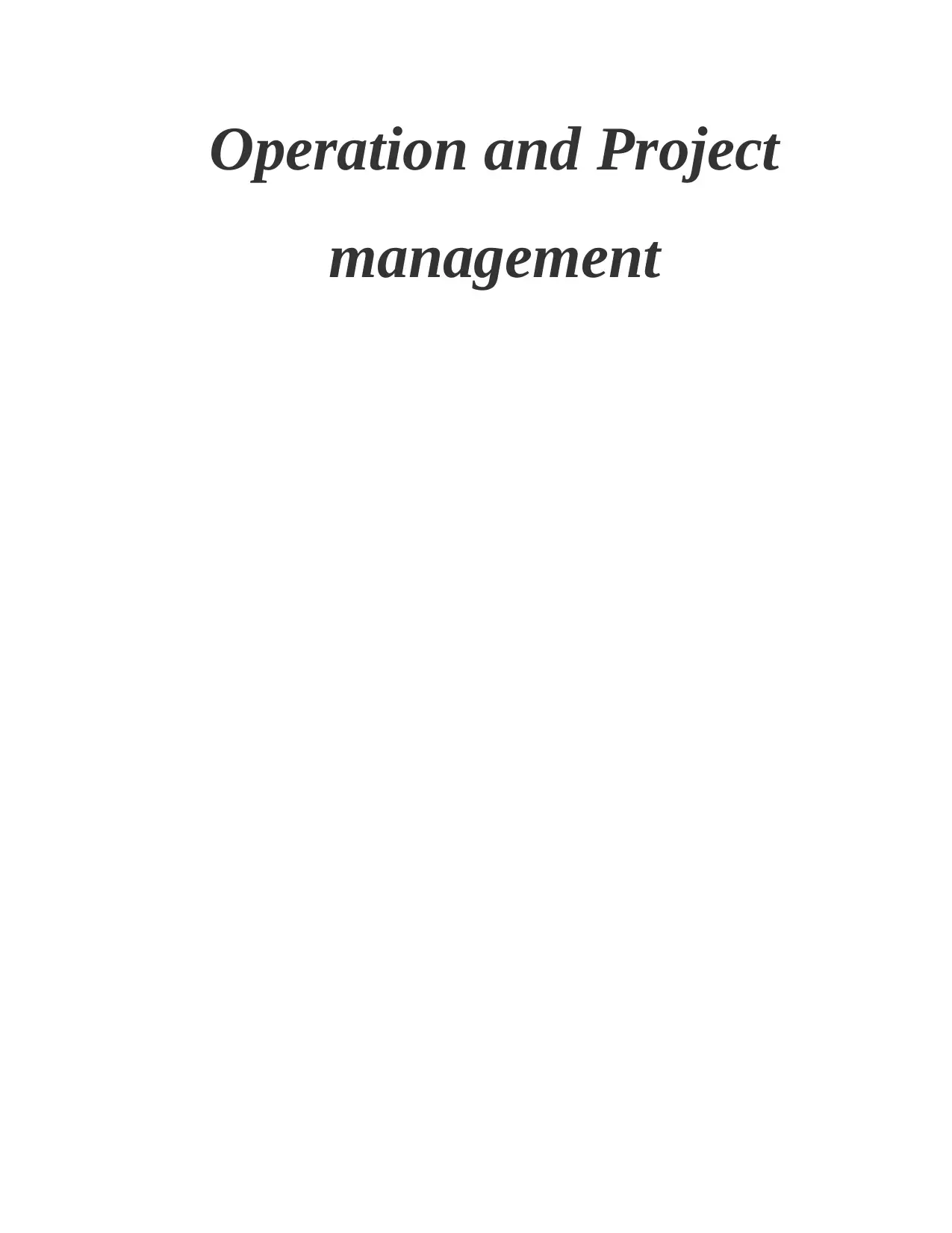
Operation and Project
management
management
Paraphrase This Document
Need a fresh take? Get an instant paraphrase of this document with our AI Paraphraser
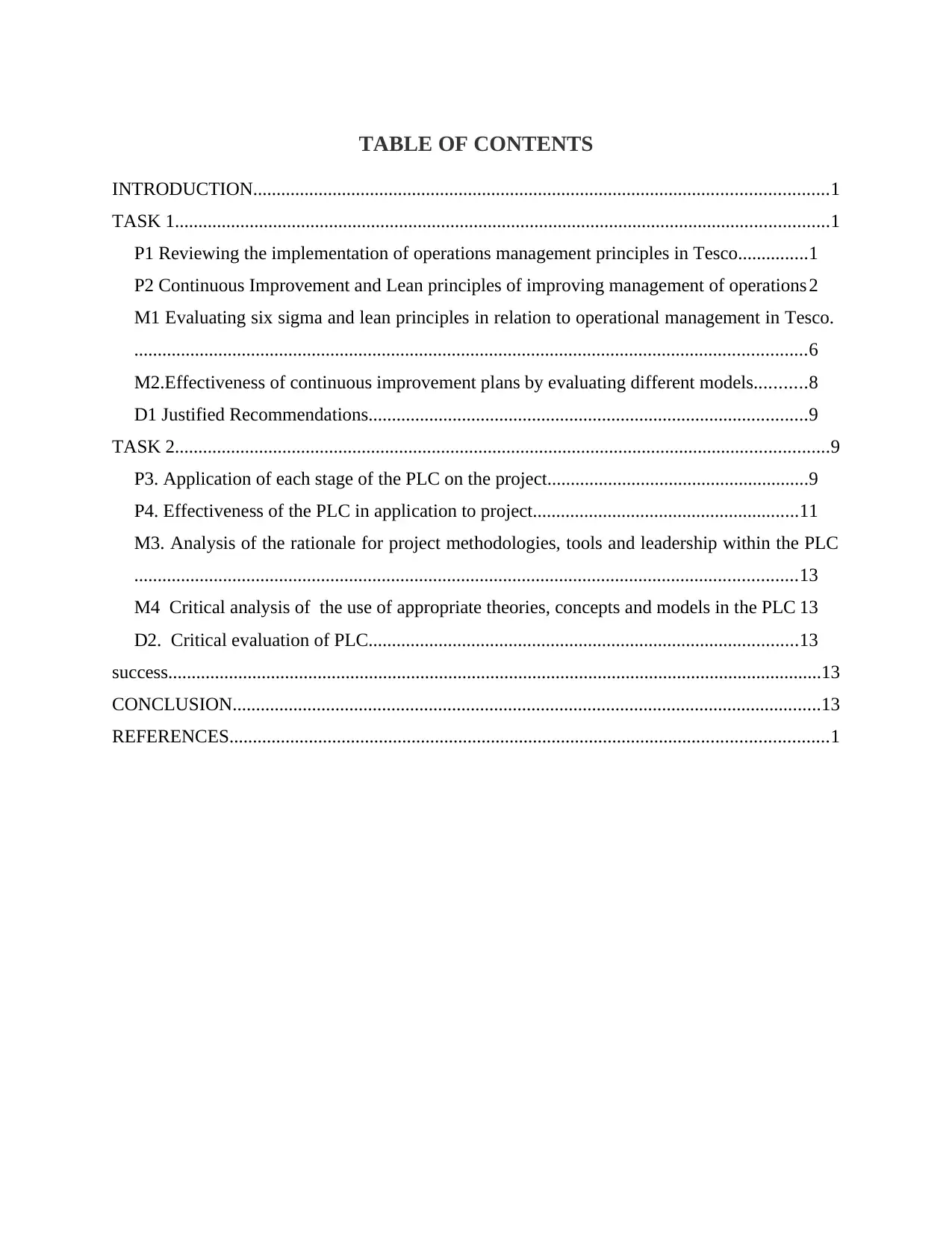
TABLE OF CONTENTS
INTRODUCTION...........................................................................................................................1
TASK 1............................................................................................................................................1
P1 Reviewing the implementation of operations management principles in Tesco...............1
P2 Continuous Improvement and Lean principles of improving management of operations 2
M1 Evaluating six sigma and lean principles in relation to operational management in Tesco.
................................................................................................................................................6
M2.Effectiveness of continuous improvement plans by evaluating different models...........8
D1 Justified Recommendations..............................................................................................9
TASK 2............................................................................................................................................9
P3. Application of each stage of the PLC on the project........................................................9
P4. Effectiveness of the PLC in application to project.........................................................11
M3. Analysis of the rationale for project methodologies, tools and leadership within the PLC
..............................................................................................................................................13
M4 Critical analysis of the use of appropriate theories, concepts and models in the PLC 13
D2. Critical evaluation of PLC............................................................................................13
success............................................................................................................................................13
CONCLUSION..............................................................................................................................13
REFERENCES................................................................................................................................1
INTRODUCTION...........................................................................................................................1
TASK 1............................................................................................................................................1
P1 Reviewing the implementation of operations management principles in Tesco...............1
P2 Continuous Improvement and Lean principles of improving management of operations 2
M1 Evaluating six sigma and lean principles in relation to operational management in Tesco.
................................................................................................................................................6
M2.Effectiveness of continuous improvement plans by evaluating different models...........8
D1 Justified Recommendations..............................................................................................9
TASK 2............................................................................................................................................9
P3. Application of each stage of the PLC on the project........................................................9
P4. Effectiveness of the PLC in application to project.........................................................11
M3. Analysis of the rationale for project methodologies, tools and leadership within the PLC
..............................................................................................................................................13
M4 Critical analysis of the use of appropriate theories, concepts and models in the PLC 13
D2. Critical evaluation of PLC............................................................................................13
success............................................................................................................................................13
CONCLUSION..............................................................................................................................13
REFERENCES................................................................................................................................1
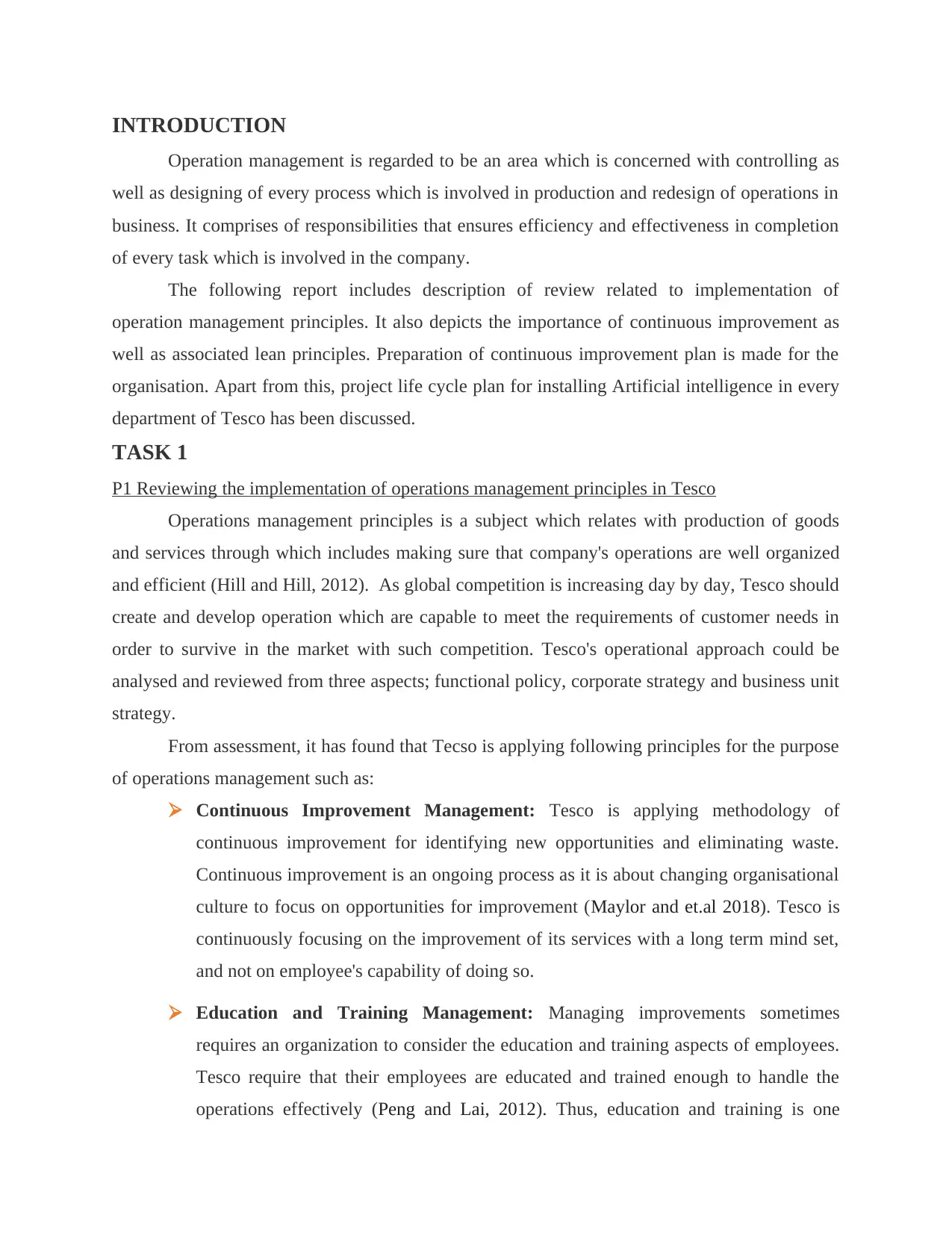
INTRODUCTION
Operation management is regarded to be an area which is concerned with controlling as
well as designing of every process which is involved in production and redesign of operations in
business. It comprises of responsibilities that ensures efficiency and effectiveness in completion
of every task which is involved in the company.
The following report includes description of review related to implementation of
operation management principles. It also depicts the importance of continuous improvement as
well as associated lean principles. Preparation of continuous improvement plan is made for the
organisation. Apart from this, project life cycle plan for installing Artificial intelligence in every
department of Tesco has been discussed.
TASK 1
P1 Reviewing the implementation of operations management principles in Tesco
Operations management principles is a subject which relates with production of goods
and services through which includes making sure that company's operations are well organized
and efficient (Hill and Hill, 2012). As global competition is increasing day by day, Tesco should
create and develop operation which are capable to meet the requirements of customer needs in
order to survive in the market with such competition. Tesco's operational approach could be
analysed and reviewed from three aspects; functional policy, corporate strategy and business unit
strategy.
From assessment, it has found that Tecso is applying following principles for the purpose
of operations management such as:
Continuous Improvement Management: Tesco is applying methodology of
continuous improvement for identifying new opportunities and eliminating waste.
Continuous improvement is an ongoing process as it is about changing organisational
culture to focus on opportunities for improvement (Maylor and et.al 2018). Tesco is
continuously focusing on the improvement of its services with a long term mind set,
and not on employee's capability of doing so.
Education and Training Management: Managing improvements sometimes
requires an organization to consider the education and training aspects of employees.
Tesco require that their employees are educated and trained enough to handle the
operations effectively (Peng and Lai, 2012). Thus, education and training is one
Operation management is regarded to be an area which is concerned with controlling as
well as designing of every process which is involved in production and redesign of operations in
business. It comprises of responsibilities that ensures efficiency and effectiveness in completion
of every task which is involved in the company.
The following report includes description of review related to implementation of
operation management principles. It also depicts the importance of continuous improvement as
well as associated lean principles. Preparation of continuous improvement plan is made for the
organisation. Apart from this, project life cycle plan for installing Artificial intelligence in every
department of Tesco has been discussed.
TASK 1
P1 Reviewing the implementation of operations management principles in Tesco
Operations management principles is a subject which relates with production of goods
and services through which includes making sure that company's operations are well organized
and efficient (Hill and Hill, 2012). As global competition is increasing day by day, Tesco should
create and develop operation which are capable to meet the requirements of customer needs in
order to survive in the market with such competition. Tesco's operational approach could be
analysed and reviewed from three aspects; functional policy, corporate strategy and business unit
strategy.
From assessment, it has found that Tecso is applying following principles for the purpose
of operations management such as:
Continuous Improvement Management: Tesco is applying methodology of
continuous improvement for identifying new opportunities and eliminating waste.
Continuous improvement is an ongoing process as it is about changing organisational
culture to focus on opportunities for improvement (Maylor and et.al 2018). Tesco is
continuously focusing on the improvement of its services with a long term mind set,
and not on employee's capability of doing so.
Education and Training Management: Managing improvements sometimes
requires an organization to consider the education and training aspects of employees.
Tesco require that their employees are educated and trained enough to handle the
operations effectively (Peng and Lai, 2012). Thus, education and training is one
⊘ This is a preview!⊘
Do you want full access?
Subscribe today to unlock all pages.

Trusted by 1+ million students worldwide
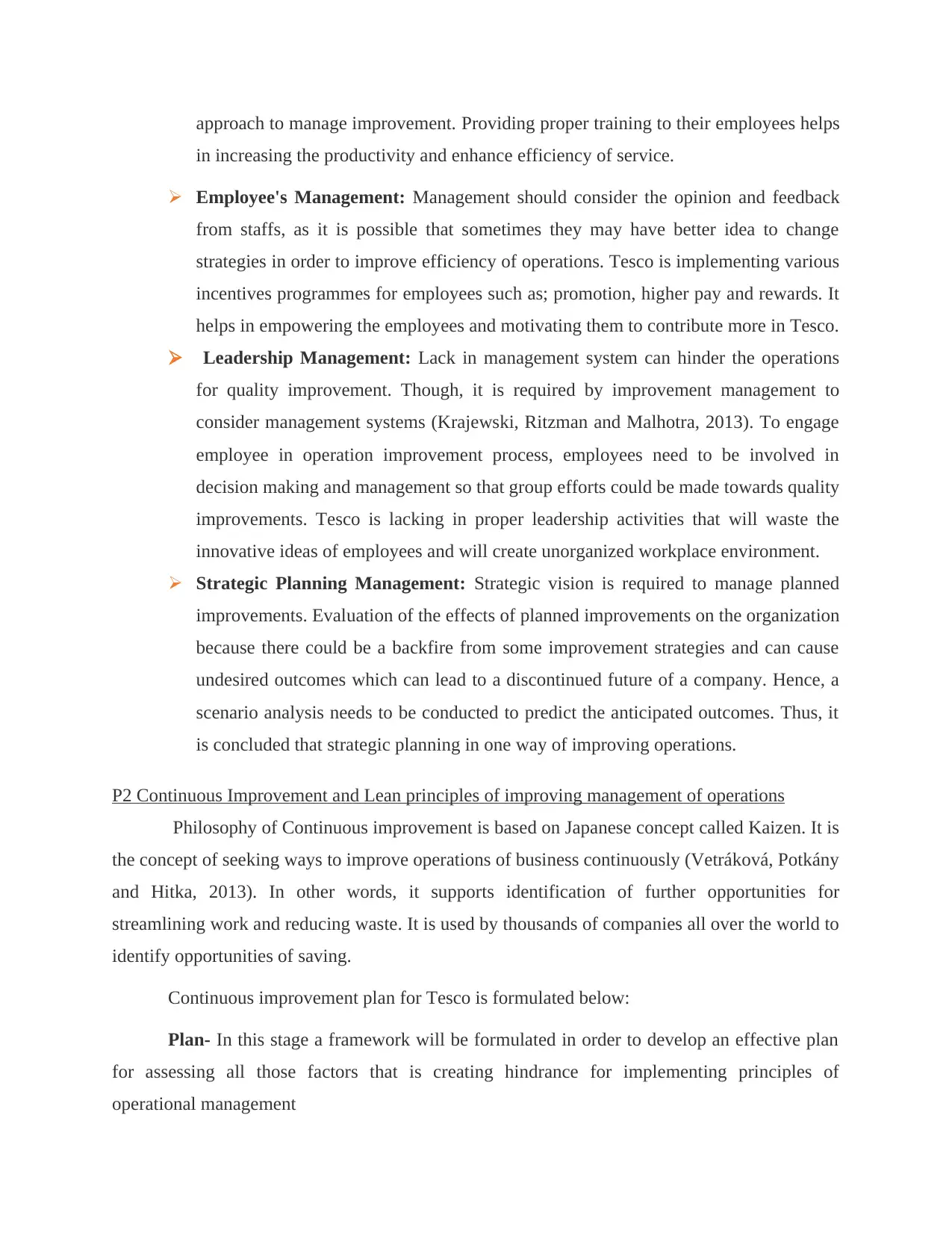
approach to manage improvement. Providing proper training to their employees helps
in increasing the productivity and enhance efficiency of service.
Employee's Management: Management should consider the opinion and feedback
from staffs, as it is possible that sometimes they may have better idea to change
strategies in order to improve efficiency of operations. Tesco is implementing various
incentives programmes for employees such as; promotion, higher pay and rewards. It
helps in empowering the employees and motivating them to contribute more in Tesco.
Leadership Management: Lack in management system can hinder the operations
for quality improvement. Though, it is required by improvement management to
consider management systems (Krajewski, Ritzman and Malhotra, 2013). To engage
employee in operation improvement process, employees need to be involved in
decision making and management so that group efforts could be made towards quality
improvements. Tesco is lacking in proper leadership activities that will waste the
innovative ideas of employees and will create unorganized workplace environment.
Strategic Planning Management: Strategic vision is required to manage planned
improvements. Evaluation of the effects of planned improvements on the organization
because there could be a backfire from some improvement strategies and can cause
undesired outcomes which can lead to a discontinued future of a company. Hence, a
scenario analysis needs to be conducted to predict the anticipated outcomes. Thus, it
is concluded that strategic planning in one way of improving operations.
P2 Continuous Improvement and Lean principles of improving management of operations
Philosophy of Continuous improvement is based on Japanese concept called Kaizen. It is
the concept of seeking ways to improve operations of business continuously (Vetráková, Potkány
and Hitka, 2013). In other words, it supports identification of further opportunities for
streamlining work and reducing waste. It is used by thousands of companies all over the world to
identify opportunities of saving.
Continuous improvement plan for Tesco is formulated below:
Plan- In this stage a framework will be formulated in order to develop an effective plan
for assessing all those factors that is creating hindrance for implementing principles of
operational management
in increasing the productivity and enhance efficiency of service.
Employee's Management: Management should consider the opinion and feedback
from staffs, as it is possible that sometimes they may have better idea to change
strategies in order to improve efficiency of operations. Tesco is implementing various
incentives programmes for employees such as; promotion, higher pay and rewards. It
helps in empowering the employees and motivating them to contribute more in Tesco.
Leadership Management: Lack in management system can hinder the operations
for quality improvement. Though, it is required by improvement management to
consider management systems (Krajewski, Ritzman and Malhotra, 2013). To engage
employee in operation improvement process, employees need to be involved in
decision making and management so that group efforts could be made towards quality
improvements. Tesco is lacking in proper leadership activities that will waste the
innovative ideas of employees and will create unorganized workplace environment.
Strategic Planning Management: Strategic vision is required to manage planned
improvements. Evaluation of the effects of planned improvements on the organization
because there could be a backfire from some improvement strategies and can cause
undesired outcomes which can lead to a discontinued future of a company. Hence, a
scenario analysis needs to be conducted to predict the anticipated outcomes. Thus, it
is concluded that strategic planning in one way of improving operations.
P2 Continuous Improvement and Lean principles of improving management of operations
Philosophy of Continuous improvement is based on Japanese concept called Kaizen. It is
the concept of seeking ways to improve operations of business continuously (Vetráková, Potkány
and Hitka, 2013). In other words, it supports identification of further opportunities for
streamlining work and reducing waste. It is used by thousands of companies all over the world to
identify opportunities of saving.
Continuous improvement plan for Tesco is formulated below:
Plan- In this stage a framework will be formulated in order to develop an effective plan
for assessing all those factors that is creating hindrance for implementing principles of
operational management
Paraphrase This Document
Need a fresh take? Get an instant paraphrase of this document with our AI Paraphraser
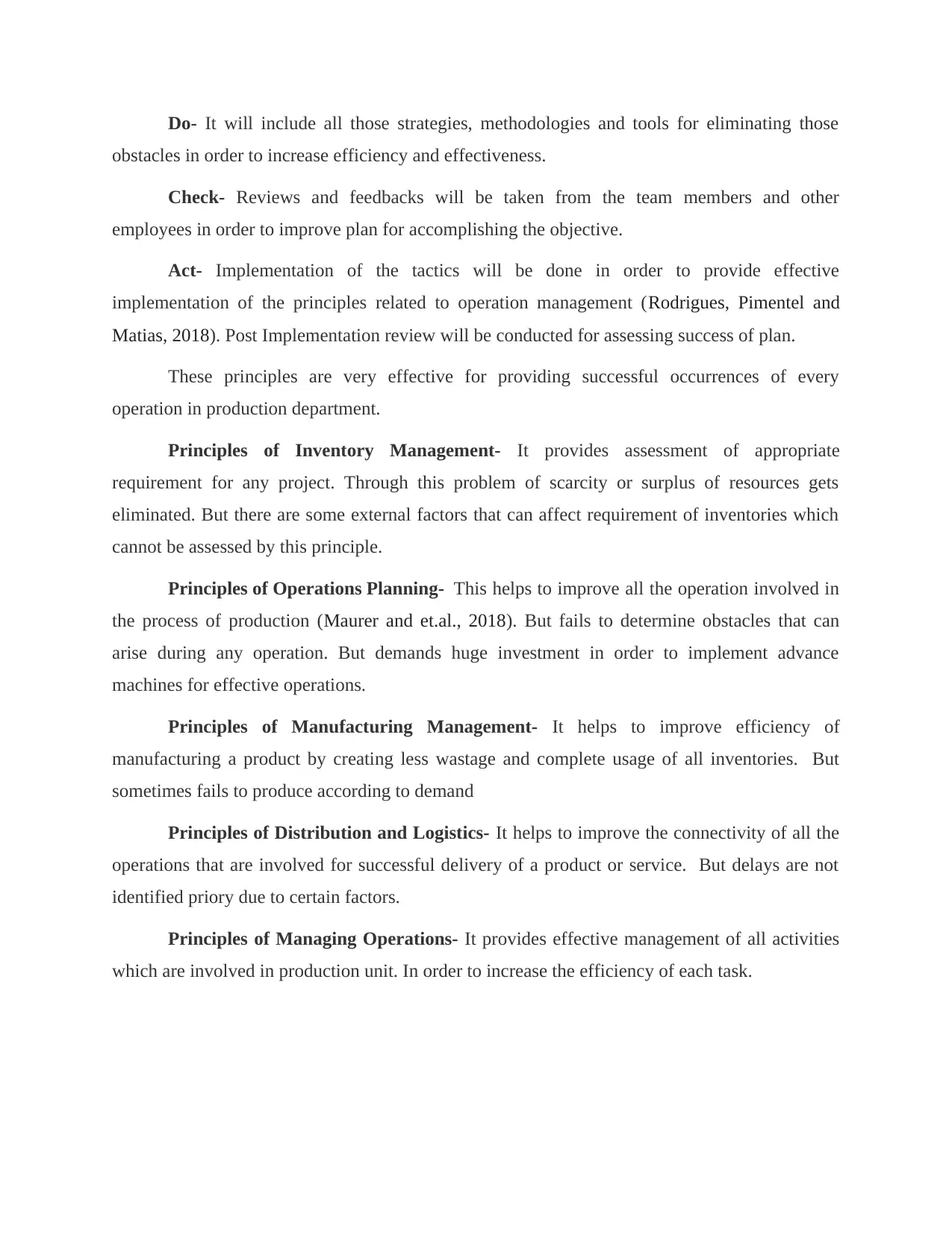
Do- It will include all those strategies, methodologies and tools for eliminating those
obstacles in order to increase efficiency and effectiveness.
Check- Reviews and feedbacks will be taken from the team members and other
employees in order to improve plan for accomplishing the objective.
Act- Implementation of the tactics will be done in order to provide effective
implementation of the principles related to operation management (Rodrigues, Pimentel and
Matias, 2018). Post Implementation review will be conducted for assessing success of plan.
These principles are very effective for providing successful occurrences of every
operation in production department.
Principles of Inventory Management- It provides assessment of appropriate
requirement for any project. Through this problem of scarcity or surplus of resources gets
eliminated. But there are some external factors that can affect requirement of inventories which
cannot be assessed by this principle.
Principles of Operations Planning- This helps to improve all the operation involved in
the process of production (Maurer and et.al., 2018). But fails to determine obstacles that can
arise during any operation. But demands huge investment in order to implement advance
machines for effective operations.
Principles of Manufacturing Management- It helps to improve efficiency of
manufacturing a product by creating less wastage and complete usage of all inventories. But
sometimes fails to produce according to demand
Principles of Distribution and Logistics- It helps to improve the connectivity of all the
operations that are involved for successful delivery of a product or service. But delays are not
identified priory due to certain factors.
Principles of Managing Operations- It provides effective management of all activities
which are involved in production unit. In order to increase the efficiency of each task.
obstacles in order to increase efficiency and effectiveness.
Check- Reviews and feedbacks will be taken from the team members and other
employees in order to improve plan for accomplishing the objective.
Act- Implementation of the tactics will be done in order to provide effective
implementation of the principles related to operation management (Rodrigues, Pimentel and
Matias, 2018). Post Implementation review will be conducted for assessing success of plan.
These principles are very effective for providing successful occurrences of every
operation in production department.
Principles of Inventory Management- It provides assessment of appropriate
requirement for any project. Through this problem of scarcity or surplus of resources gets
eliminated. But there are some external factors that can affect requirement of inventories which
cannot be assessed by this principle.
Principles of Operations Planning- This helps to improve all the operation involved in
the process of production (Maurer and et.al., 2018). But fails to determine obstacles that can
arise during any operation. But demands huge investment in order to implement advance
machines for effective operations.
Principles of Manufacturing Management- It helps to improve efficiency of
manufacturing a product by creating less wastage and complete usage of all inventories. But
sometimes fails to produce according to demand
Principles of Distribution and Logistics- It helps to improve the connectivity of all the
operations that are involved for successful delivery of a product or service. But delays are not
identified priory due to certain factors.
Principles of Managing Operations- It provides effective management of all activities
which are involved in production unit. In order to increase the efficiency of each task.
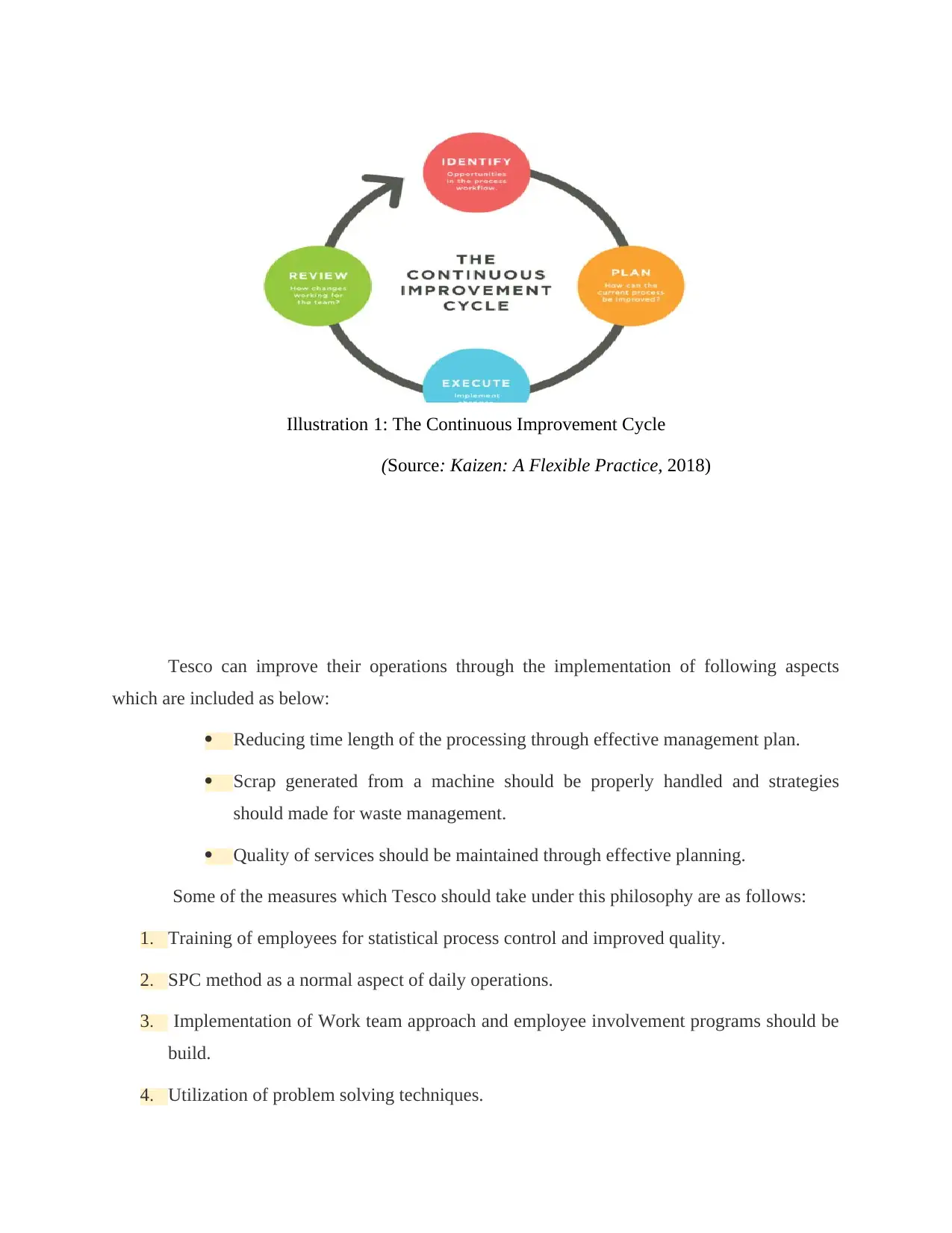
Tesco can improve their operations through the implementation of following aspects
which are included as below:
Reducing time length of the processing through effective management plan.
Scrap generated from a machine should be properly handled and strategies
should made for waste management.
Quality of services should be maintained through effective planning.
Some of the measures which Tesco should take under this philosophy are as follows:
1. Training of employees for statistical process control and improved quality.
2. SPC method as a normal aspect of daily operations.
3. Implementation of Work team approach and employee involvement programs should be
build.
4. Utilization of problem solving techniques.
Illustration 1: The Continuous Improvement Cycle
(Source: Kaizen: A Flexible Practice, 2018)
which are included as below:
Reducing time length of the processing through effective management plan.
Scrap generated from a machine should be properly handled and strategies
should made for waste management.
Quality of services should be maintained through effective planning.
Some of the measures which Tesco should take under this philosophy are as follows:
1. Training of employees for statistical process control and improved quality.
2. SPC method as a normal aspect of daily operations.
3. Implementation of Work team approach and employee involvement programs should be
build.
4. Utilization of problem solving techniques.
Illustration 1: The Continuous Improvement Cycle
(Source: Kaizen: A Flexible Practice, 2018)
⊘ This is a preview!⊘
Do you want full access?
Subscribe today to unlock all pages.

Trusted by 1+ million students worldwide
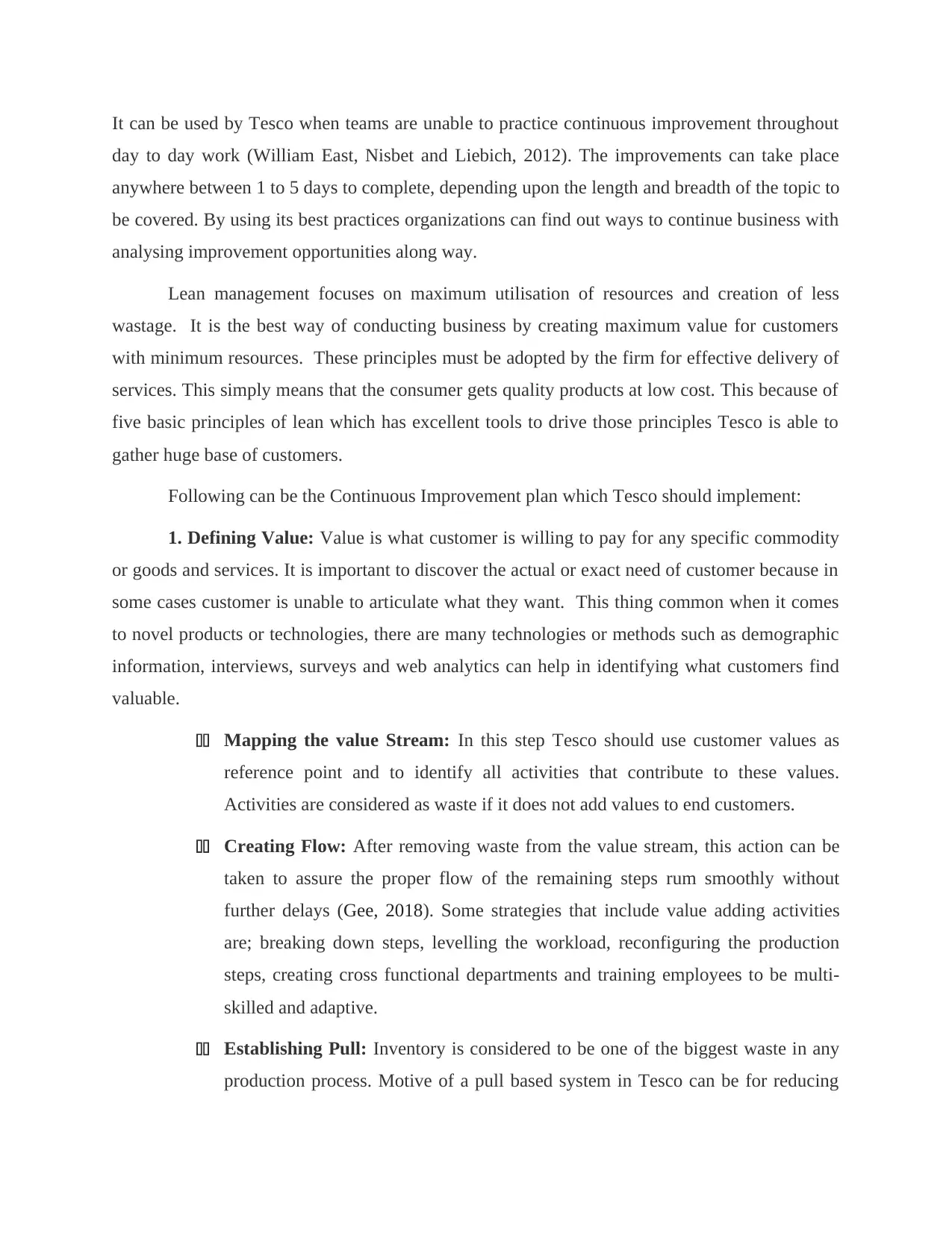
It can be used by Tesco when teams are unable to practice continuous improvement throughout
day to day work (William East, Nisbet and Liebich, 2012). The improvements can take place
anywhere between 1 to 5 days to complete, depending upon the length and breadth of the topic to
be covered. By using its best practices organizations can find out ways to continue business with
analysing improvement opportunities along way.
Lean management focuses on maximum utilisation of resources and creation of less
wastage. It is the best way of conducting business by creating maximum value for customers
with minimum resources. These principles must be adopted by the firm for effective delivery of
services. This simply means that the consumer gets quality products at low cost. This because of
five basic principles of lean which has excellent tools to drive those principles Tesco is able to
gather huge base of customers.
Following can be the Continuous Improvement plan which Tesco should implement:
1. Defining Value: Value is what customer is willing to pay for any specific commodity
or goods and services. It is important to discover the actual or exact need of customer because in
some cases customer is unable to articulate what they want. This thing common when it comes
to novel products or technologies, there are many technologies or methods such as demographic
information, interviews, surveys and web analytics can help in identifying what customers find
valuable.
11 Mapping the value Stream: In this step Tesco should use customer values as
reference point and to identify all activities that contribute to these values.
Activities are considered as waste if it does not add values to end customers.
11 Creating Flow: After removing waste from the value stream, this action can be
taken to assure the proper flow of the remaining steps rum smoothly without
further delays (Gee, 2018). Some strategies that include value adding activities
are; breaking down steps, levelling the workload, reconfiguring the production
steps, creating cross functional departments and training employees to be multi-
skilled and adaptive.
11 Establishing Pull: Inventory is considered to be one of the biggest waste in any
production process. Motive of a pull based system in Tesco can be for reducing
day to day work (William East, Nisbet and Liebich, 2012). The improvements can take place
anywhere between 1 to 5 days to complete, depending upon the length and breadth of the topic to
be covered. By using its best practices organizations can find out ways to continue business with
analysing improvement opportunities along way.
Lean management focuses on maximum utilisation of resources and creation of less
wastage. It is the best way of conducting business by creating maximum value for customers
with minimum resources. These principles must be adopted by the firm for effective delivery of
services. This simply means that the consumer gets quality products at low cost. This because of
five basic principles of lean which has excellent tools to drive those principles Tesco is able to
gather huge base of customers.
Following can be the Continuous Improvement plan which Tesco should implement:
1. Defining Value: Value is what customer is willing to pay for any specific commodity
or goods and services. It is important to discover the actual or exact need of customer because in
some cases customer is unable to articulate what they want. This thing common when it comes
to novel products or technologies, there are many technologies or methods such as demographic
information, interviews, surveys and web analytics can help in identifying what customers find
valuable.
11 Mapping the value Stream: In this step Tesco should use customer values as
reference point and to identify all activities that contribute to these values.
Activities are considered as waste if it does not add values to end customers.
11 Creating Flow: After removing waste from the value stream, this action can be
taken to assure the proper flow of the remaining steps rum smoothly without
further delays (Gee, 2018). Some strategies that include value adding activities
are; breaking down steps, levelling the workload, reconfiguring the production
steps, creating cross functional departments and training employees to be multi-
skilled and adaptive.
11 Establishing Pull: Inventory is considered to be one of the biggest waste in any
production process. Motive of a pull based system in Tesco can be for reducing
Paraphrase This Document
Need a fresh take? Get an instant paraphrase of this document with our AI Paraphraser
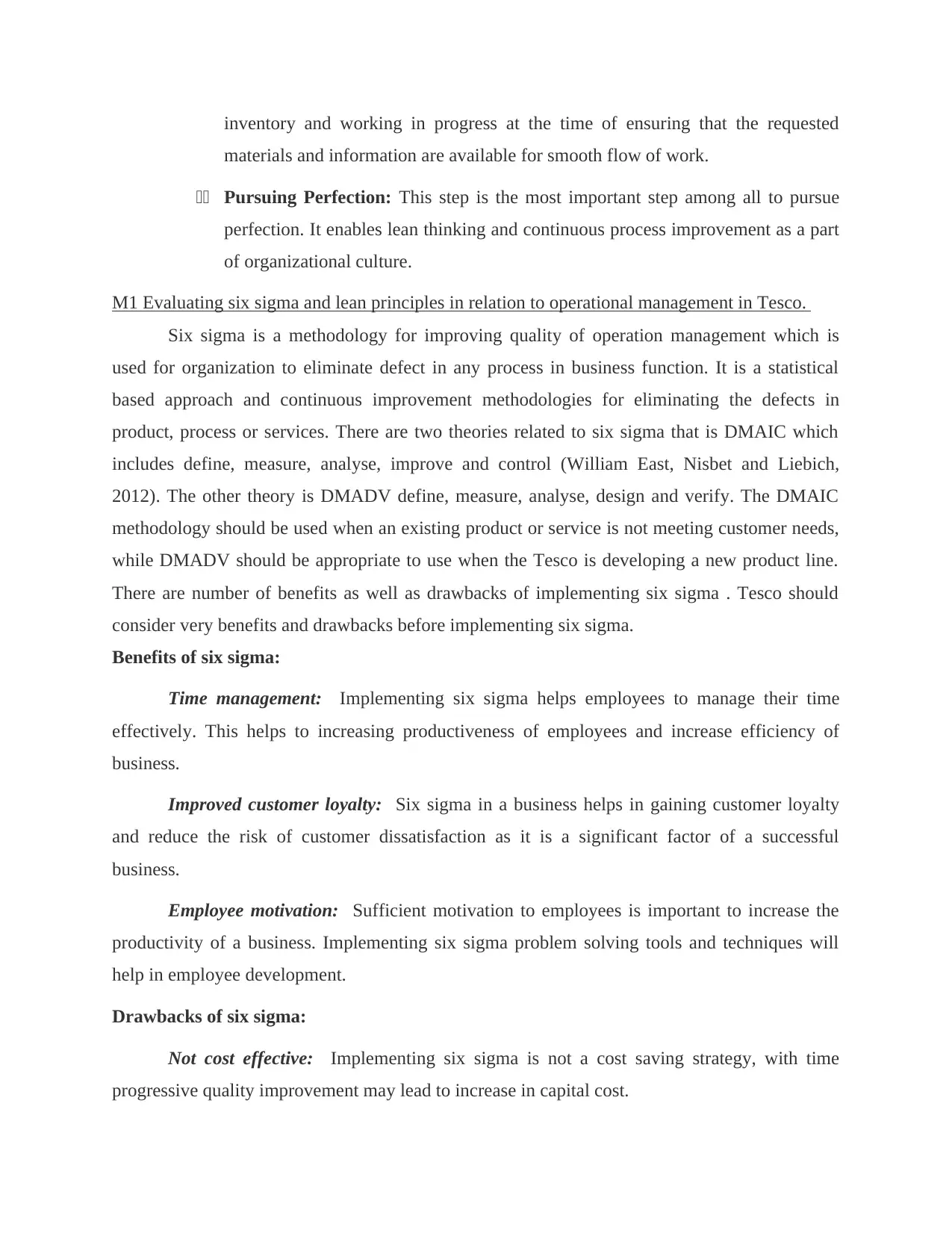
inventory and working in progress at the time of ensuring that the requested
materials and information are available for smooth flow of work.
11 Pursuing Perfection: This step is the most important step among all to pursue
perfection. It enables lean thinking and continuous process improvement as a part
of organizational culture.
M1 Evaluating six sigma and lean principles in relation to operational management in Tesco.
Six sigma is a methodology for improving quality of operation management which is
used for organization to eliminate defect in any process in business function. It is a statistical
based approach and continuous improvement methodologies for eliminating the defects in
product, process or services. There are two theories related to six sigma that is DMAIC which
includes define, measure, analyse, improve and control (William East, Nisbet and Liebich,
2012). The other theory is DMADV define, measure, analyse, design and verify. The DMAIC
methodology should be used when an existing product or service is not meeting customer needs,
while DMADV should be appropriate to use when the Tesco is developing a new product line.
There are number of benefits as well as drawbacks of implementing six sigma . Tesco should
consider very benefits and drawbacks before implementing six sigma.
Benefits of six sigma:
Time management: Implementing six sigma helps employees to manage their time
effectively. This helps to increasing productiveness of employees and increase efficiency of
business.
Improved customer loyalty: Six sigma in a business helps in gaining customer loyalty
and reduce the risk of customer dissatisfaction as it is a significant factor of a successful
business.
Employee motivation: Sufficient motivation to employees is important to increase the
productivity of a business. Implementing six sigma problem solving tools and techniques will
help in employee development.
Drawbacks of six sigma:
Not cost effective: Implementing six sigma is not a cost saving strategy, with time
progressive quality improvement may lead to increase in capital cost.
materials and information are available for smooth flow of work.
11 Pursuing Perfection: This step is the most important step among all to pursue
perfection. It enables lean thinking and continuous process improvement as a part
of organizational culture.
M1 Evaluating six sigma and lean principles in relation to operational management in Tesco.
Six sigma is a methodology for improving quality of operation management which is
used for organization to eliminate defect in any process in business function. It is a statistical
based approach and continuous improvement methodologies for eliminating the defects in
product, process or services. There are two theories related to six sigma that is DMAIC which
includes define, measure, analyse, improve and control (William East, Nisbet and Liebich,
2012). The other theory is DMADV define, measure, analyse, design and verify. The DMAIC
methodology should be used when an existing product or service is not meeting customer needs,
while DMADV should be appropriate to use when the Tesco is developing a new product line.
There are number of benefits as well as drawbacks of implementing six sigma . Tesco should
consider very benefits and drawbacks before implementing six sigma.
Benefits of six sigma:
Time management: Implementing six sigma helps employees to manage their time
effectively. This helps to increasing productiveness of employees and increase efficiency of
business.
Improved customer loyalty: Six sigma in a business helps in gaining customer loyalty
and reduce the risk of customer dissatisfaction as it is a significant factor of a successful
business.
Employee motivation: Sufficient motivation to employees is important to increase the
productivity of a business. Implementing six sigma problem solving tools and techniques will
help in employee development.
Drawbacks of six sigma:
Not cost effective: Implementing six sigma is not a cost saving strategy, with time
progressive quality improvement may lead to increase in capital cost.
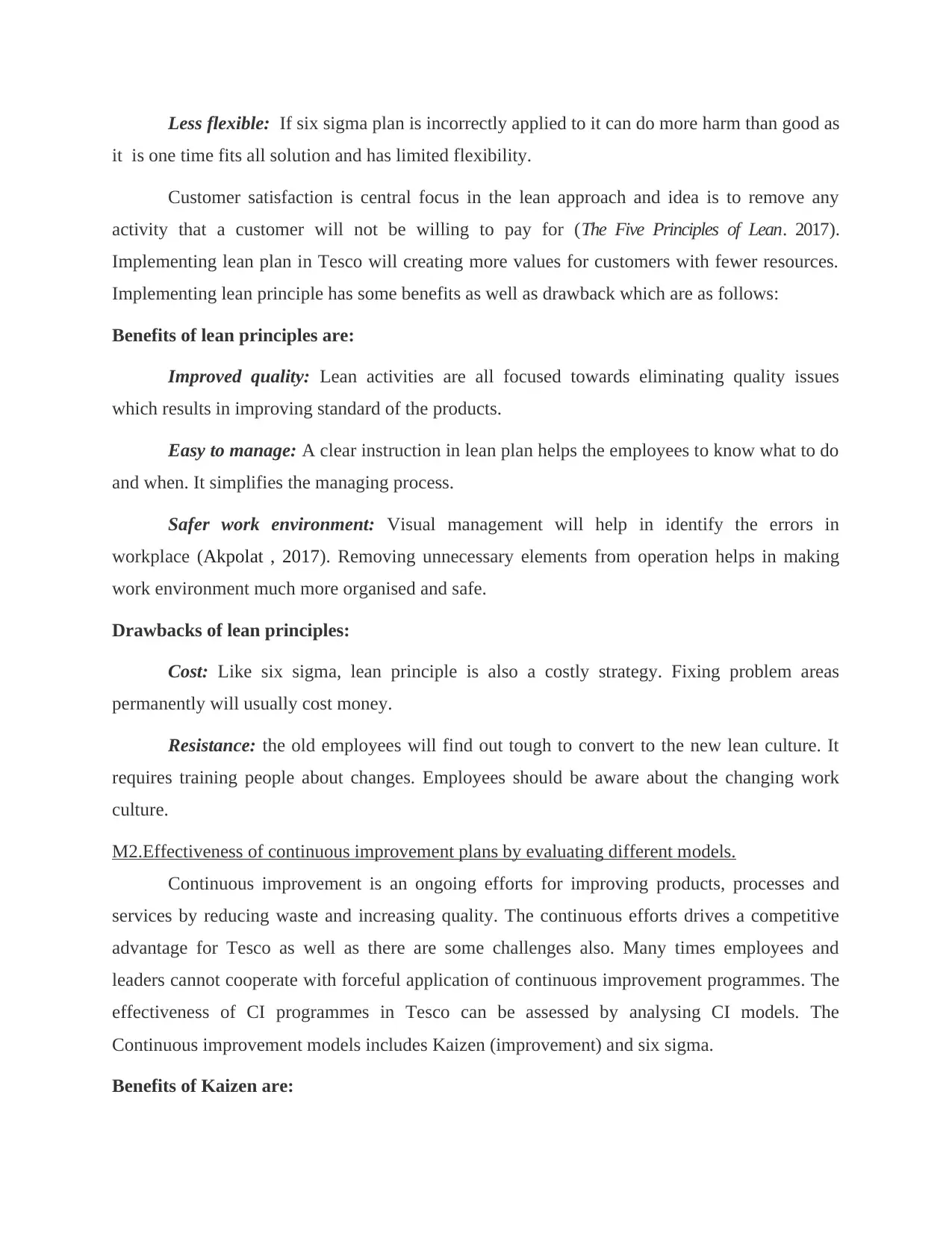
Less flexible: If six sigma plan is incorrectly applied to it can do more harm than good as
it is one time fits all solution and has limited flexibility.
Customer satisfaction is central focus in the lean approach and idea is to remove any
activity that a customer will not be willing to pay for (The Five Principles of Lean. 2017).
Implementing lean plan in Tesco will creating more values for customers with fewer resources.
Implementing lean principle has some benefits as well as drawback which are as follows:
Benefits of lean principles are:
Improved quality: Lean activities are all focused towards eliminating quality issues
which results in improving standard of the products.
Easy to manage: A clear instruction in lean plan helps the employees to know what to do
and when. It simplifies the managing process.
Safer work environment: Visual management will help in identify the errors in
workplace (Akpolat , 2017). Removing unnecessary elements from operation helps in making
work environment much more organised and safe.
Drawbacks of lean principles:
Cost: Like six sigma, lean principle is also a costly strategy. Fixing problem areas
permanently will usually cost money.
Resistance: the old employees will find out tough to convert to the new lean culture. It
requires training people about changes. Employees should be aware about the changing work
culture.
M2.Effectiveness of continuous improvement plans by evaluating different models.
Continuous improvement is an ongoing efforts for improving products, processes and
services by reducing waste and increasing quality. The continuous efforts drives a competitive
advantage for Tesco as well as there are some challenges also. Many times employees and
leaders cannot cooperate with forceful application of continuous improvement programmes. The
effectiveness of CI programmes in Tesco can be assessed by analysing CI models. The
Continuous improvement models includes Kaizen (improvement) and six sigma.
Benefits of Kaizen are:
it is one time fits all solution and has limited flexibility.
Customer satisfaction is central focus in the lean approach and idea is to remove any
activity that a customer will not be willing to pay for (The Five Principles of Lean. 2017).
Implementing lean plan in Tesco will creating more values for customers with fewer resources.
Implementing lean principle has some benefits as well as drawback which are as follows:
Benefits of lean principles are:
Improved quality: Lean activities are all focused towards eliminating quality issues
which results in improving standard of the products.
Easy to manage: A clear instruction in lean plan helps the employees to know what to do
and when. It simplifies the managing process.
Safer work environment: Visual management will help in identify the errors in
workplace (Akpolat , 2017). Removing unnecessary elements from operation helps in making
work environment much more organised and safe.
Drawbacks of lean principles:
Cost: Like six sigma, lean principle is also a costly strategy. Fixing problem areas
permanently will usually cost money.
Resistance: the old employees will find out tough to convert to the new lean culture. It
requires training people about changes. Employees should be aware about the changing work
culture.
M2.Effectiveness of continuous improvement plans by evaluating different models.
Continuous improvement is an ongoing efforts for improving products, processes and
services by reducing waste and increasing quality. The continuous efforts drives a competitive
advantage for Tesco as well as there are some challenges also. Many times employees and
leaders cannot cooperate with forceful application of continuous improvement programmes. The
effectiveness of CI programmes in Tesco can be assessed by analysing CI models. The
Continuous improvement models includes Kaizen (improvement) and six sigma.
Benefits of Kaizen are:
⊘ This is a preview!⊘
Do you want full access?
Subscribe today to unlock all pages.

Trusted by 1+ million students worldwide
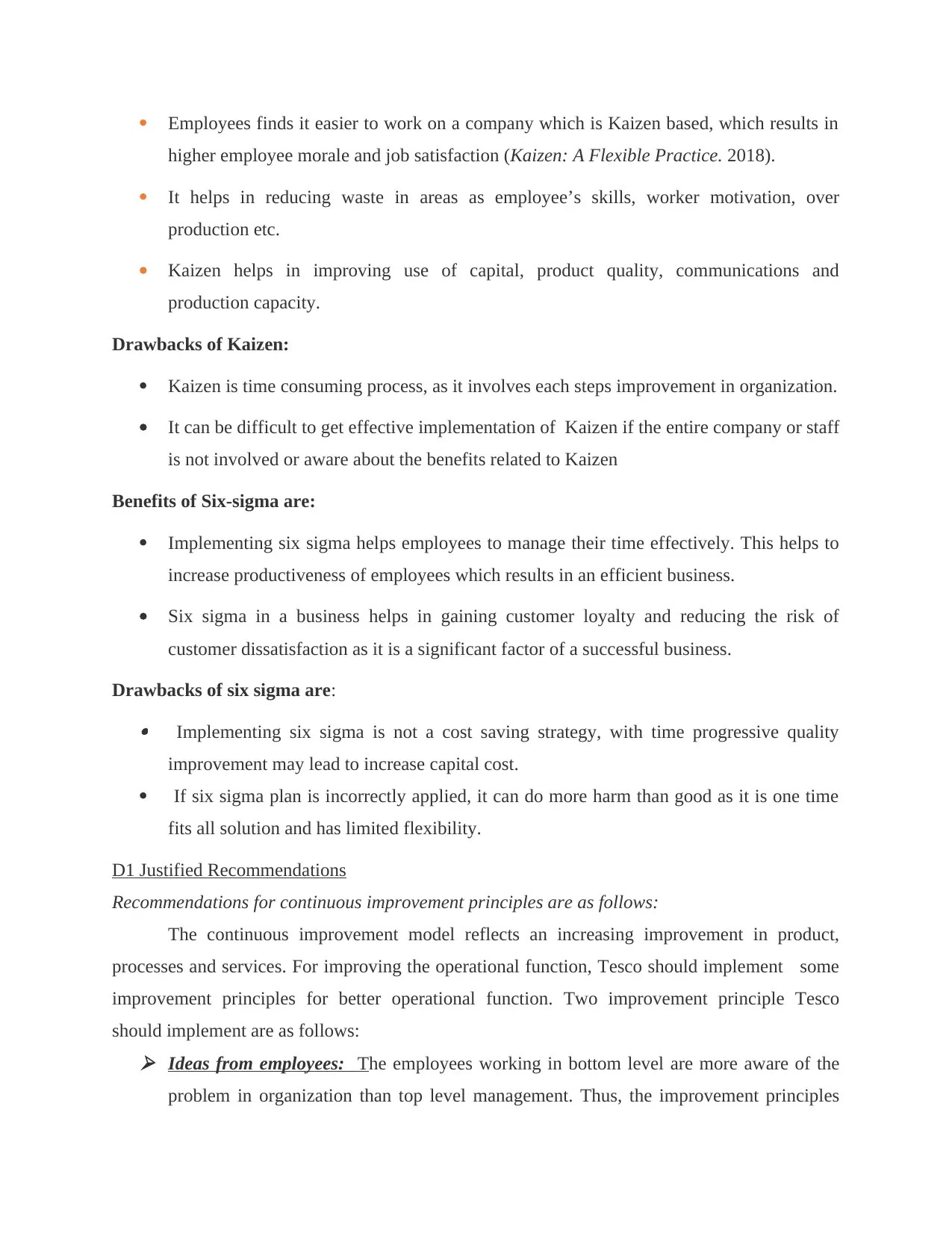
Employees finds it easier to work on a company which is Kaizen based, which results in
higher employee morale and job satisfaction (Kaizen: A Flexible Practice. 2018).
It helps in reducing waste in areas as employee’s skills, worker motivation, over
production etc.
Kaizen helps in improving use of capital, product quality, communications and
production capacity.
Drawbacks of Kaizen:
Kaizen is time consuming process, as it involves each steps improvement in organization.
It can be difficult to get effective implementation of Kaizen if the entire company or staff
is not involved or aware about the benefits related to Kaizen
Benefits of Six-sigma are:
Implementing six sigma helps employees to manage their time effectively. This helps to
increase productiveness of employees which results in an efficient business.
Six sigma in a business helps in gaining customer loyalty and reducing the risk of
customer dissatisfaction as it is a significant factor of a successful business.
Drawbacks of six sigma are: Implementing six sigma is not a cost saving strategy, with time progressive quality
improvement may lead to increase capital cost.
If six sigma plan is incorrectly applied, it can do more harm than good as it is one time
fits all solution and has limited flexibility.
D1 Justified Recommendations
Recommendations for continuous improvement principles are as follows:
The continuous improvement model reflects an increasing improvement in product,
processes and services. For improving the operational function, Tesco should implement some
improvement principles for better operational function. Two improvement principle Tesco
should implement are as follows: Ideas from employees: The employees working in bottom level are more aware of the
problem in organization than top level management. Thus, the improvement principles
higher employee morale and job satisfaction (Kaizen: A Flexible Practice. 2018).
It helps in reducing waste in areas as employee’s skills, worker motivation, over
production etc.
Kaizen helps in improving use of capital, product quality, communications and
production capacity.
Drawbacks of Kaizen:
Kaizen is time consuming process, as it involves each steps improvement in organization.
It can be difficult to get effective implementation of Kaizen if the entire company or staff
is not involved or aware about the benefits related to Kaizen
Benefits of Six-sigma are:
Implementing six sigma helps employees to manage their time effectively. This helps to
increase productiveness of employees which results in an efficient business.
Six sigma in a business helps in gaining customer loyalty and reducing the risk of
customer dissatisfaction as it is a significant factor of a successful business.
Drawbacks of six sigma are: Implementing six sigma is not a cost saving strategy, with time progressive quality
improvement may lead to increase capital cost.
If six sigma plan is incorrectly applied, it can do more harm than good as it is one time
fits all solution and has limited flexibility.
D1 Justified Recommendations
Recommendations for continuous improvement principles are as follows:
The continuous improvement model reflects an increasing improvement in product,
processes and services. For improving the operational function, Tesco should implement some
improvement principles for better operational function. Two improvement principle Tesco
should implement are as follows: Ideas from employees: The employees working in bottom level are more aware of the
problem in organization than top level management. Thus, the improvement principles
Paraphrase This Document
Need a fresh take? Get an instant paraphrase of this document with our AI Paraphraser
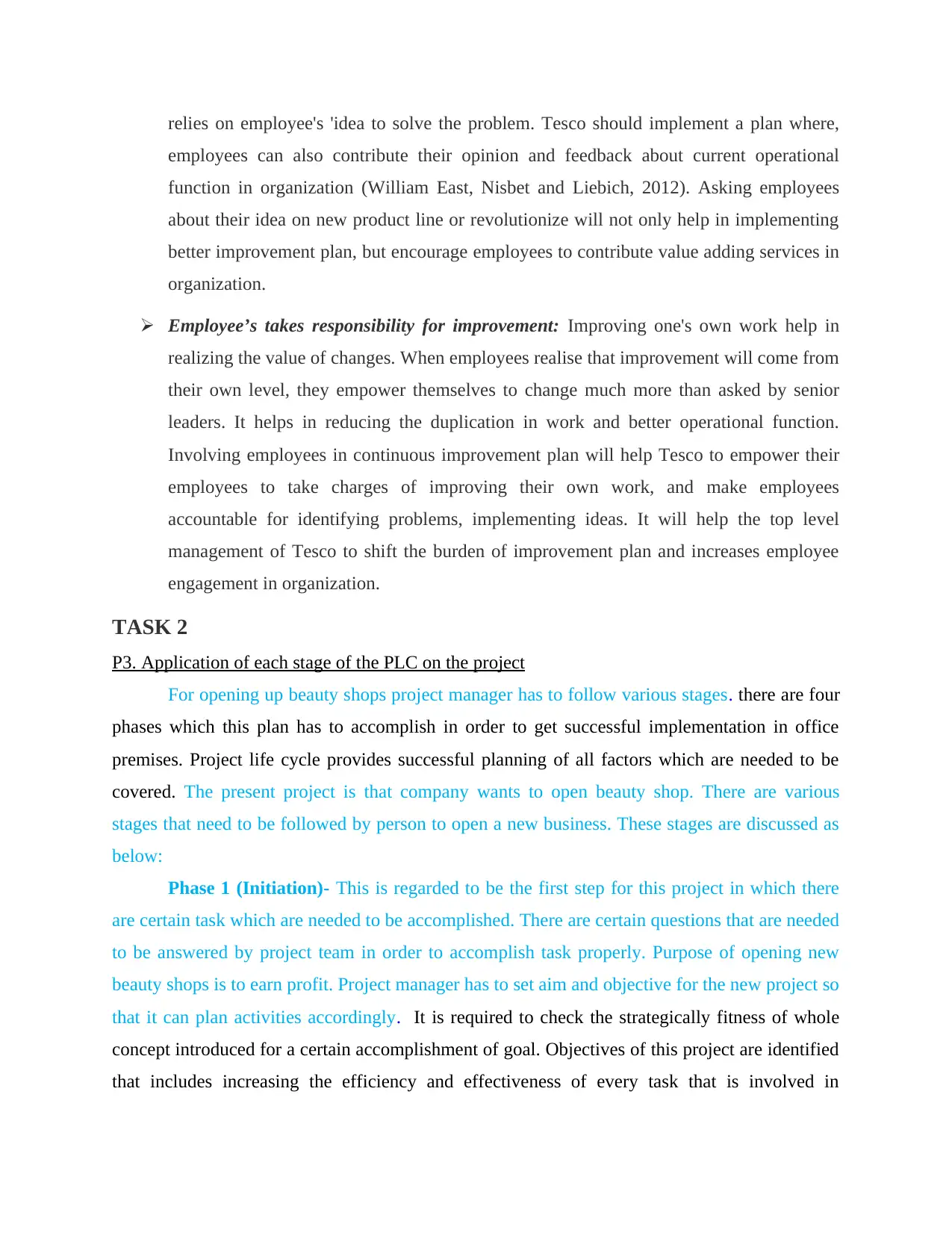
relies on employee's 'idea to solve the problem. Tesco should implement a plan where,
employees can also contribute their opinion and feedback about current operational
function in organization (William East, Nisbet and Liebich, 2012). Asking employees
about their idea on new product line or revolutionize will not only help in implementing
better improvement plan, but encourage employees to contribute value adding services in
organization.
Employee’s takes responsibility for improvement: Improving one's own work help in
realizing the value of changes. When employees realise that improvement will come from
their own level, they empower themselves to change much more than asked by senior
leaders. It helps in reducing the duplication in work and better operational function.
Involving employees in continuous improvement plan will help Tesco to empower their
employees to take charges of improving their own work, and make employees
accountable for identifying problems, implementing ideas. It will help the top level
management of Tesco to shift the burden of improvement plan and increases employee
engagement in organization.
TASK 2
P3. Application of each stage of the PLC on the project
For opening up beauty shops project manager has to follow various stages. there are four
phases which this plan has to accomplish in order to get successful implementation in office
premises. Project life cycle provides successful planning of all factors which are needed to be
covered. The present project is that company wants to open beauty shop. There are various
stages that need to be followed by person to open a new business. These stages are discussed as
below:
Phase 1 (Initiation)- This is regarded to be the first step for this project in which there
are certain task which are needed to be accomplished. There are certain questions that are needed
to be answered by project team in order to accomplish task properly. Purpose of opening new
beauty shops is to earn profit. Project manager has to set aim and objective for the new project so
that it can plan activities accordingly. It is required to check the strategically fitness of whole
concept introduced for a certain accomplishment of goal. Objectives of this project are identified
that includes increasing the efficiency and effectiveness of every task that is involved in
employees can also contribute their opinion and feedback about current operational
function in organization (William East, Nisbet and Liebich, 2012). Asking employees
about their idea on new product line or revolutionize will not only help in implementing
better improvement plan, but encourage employees to contribute value adding services in
organization.
Employee’s takes responsibility for improvement: Improving one's own work help in
realizing the value of changes. When employees realise that improvement will come from
their own level, they empower themselves to change much more than asked by senior
leaders. It helps in reducing the duplication in work and better operational function.
Involving employees in continuous improvement plan will help Tesco to empower their
employees to take charges of improving their own work, and make employees
accountable for identifying problems, implementing ideas. It will help the top level
management of Tesco to shift the burden of improvement plan and increases employee
engagement in organization.
TASK 2
P3. Application of each stage of the PLC on the project
For opening up beauty shops project manager has to follow various stages. there are four
phases which this plan has to accomplish in order to get successful implementation in office
premises. Project life cycle provides successful planning of all factors which are needed to be
covered. The present project is that company wants to open beauty shop. There are various
stages that need to be followed by person to open a new business. These stages are discussed as
below:
Phase 1 (Initiation)- This is regarded to be the first step for this project in which there
are certain task which are needed to be accomplished. There are certain questions that are needed
to be answered by project team in order to accomplish task properly. Purpose of opening new
beauty shops is to earn profit. Project manager has to set aim and objective for the new project so
that it can plan activities accordingly. It is required to check the strategically fitness of whole
concept introduced for a certain accomplishment of goal. Objectives of this project are identified
that includes increasing the efficiency and effectiveness of every task that is involved in
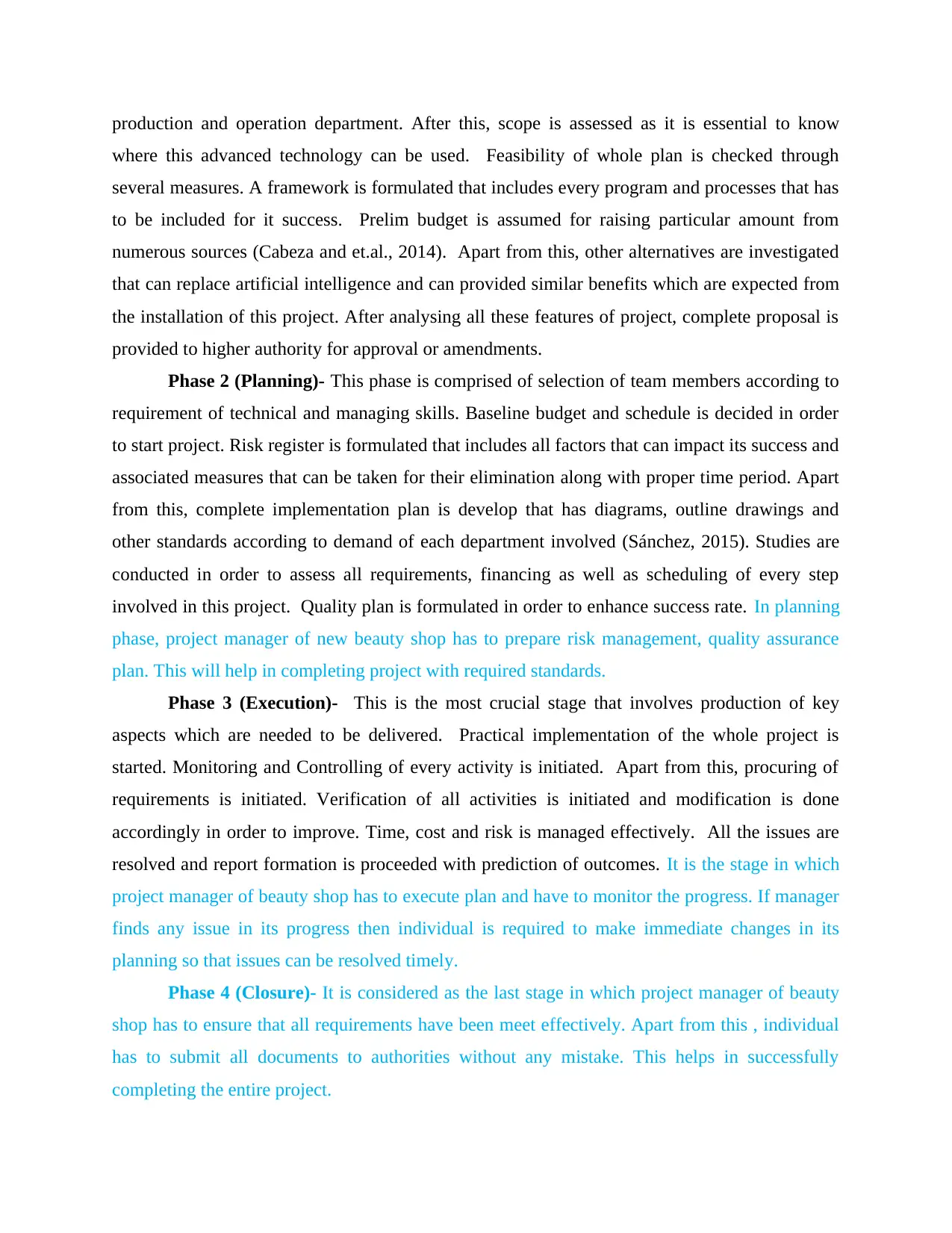
production and operation department. After this, scope is assessed as it is essential to know
where this advanced technology can be used. Feasibility of whole plan is checked through
several measures. A framework is formulated that includes every program and processes that has
to be included for it success. Prelim budget is assumed for raising particular amount from
numerous sources (Cabeza and et.al., 2014). Apart from this, other alternatives are investigated
that can replace artificial intelligence and can provided similar benefits which are expected from
the installation of this project. After analysing all these features of project, complete proposal is
provided to higher authority for approval or amendments.
Phase 2 (Planning)- This phase is comprised of selection of team members according to
requirement of technical and managing skills. Baseline budget and schedule is decided in order
to start project. Risk register is formulated that includes all factors that can impact its success and
associated measures that can be taken for their elimination along with proper time period. Apart
from this, complete implementation plan is develop that has diagrams, outline drawings and
other standards according to demand of each department involved (Sánchez, 2015). Studies are
conducted in order to assess all requirements, financing as well as scheduling of every step
involved in this project. Quality plan is formulated in order to enhance success rate. In planning
phase, project manager of new beauty shop has to prepare risk management, quality assurance
plan. This will help in completing project with required standards.
Phase 3 (Execution)- This is the most crucial stage that involves production of key
aspects which are needed to be delivered. Practical implementation of the whole project is
started. Monitoring and Controlling of every activity is initiated. Apart from this, procuring of
requirements is initiated. Verification of all activities is initiated and modification is done
accordingly in order to improve. Time, cost and risk is managed effectively. All the issues are
resolved and report formation is proceeded with prediction of outcomes. It is the stage in which
project manager of beauty shop has to execute plan and have to monitor the progress. If manager
finds any issue in its progress then individual is required to make immediate changes in its
planning so that issues can be resolved timely.
Phase 4 (Closure)- It is considered as the last stage in which project manager of beauty
shop has to ensure that all requirements have been meet effectively. Apart from this , individual
has to submit all documents to authorities without any mistake. This helps in successfully
completing the entire project.
where this advanced technology can be used. Feasibility of whole plan is checked through
several measures. A framework is formulated that includes every program and processes that has
to be included for it success. Prelim budget is assumed for raising particular amount from
numerous sources (Cabeza and et.al., 2014). Apart from this, other alternatives are investigated
that can replace artificial intelligence and can provided similar benefits which are expected from
the installation of this project. After analysing all these features of project, complete proposal is
provided to higher authority for approval or amendments.
Phase 2 (Planning)- This phase is comprised of selection of team members according to
requirement of technical and managing skills. Baseline budget and schedule is decided in order
to start project. Risk register is formulated that includes all factors that can impact its success and
associated measures that can be taken for their elimination along with proper time period. Apart
from this, complete implementation plan is develop that has diagrams, outline drawings and
other standards according to demand of each department involved (Sánchez, 2015). Studies are
conducted in order to assess all requirements, financing as well as scheduling of every step
involved in this project. Quality plan is formulated in order to enhance success rate. In planning
phase, project manager of new beauty shop has to prepare risk management, quality assurance
plan. This will help in completing project with required standards.
Phase 3 (Execution)- This is the most crucial stage that involves production of key
aspects which are needed to be delivered. Practical implementation of the whole project is
started. Monitoring and Controlling of every activity is initiated. Apart from this, procuring of
requirements is initiated. Verification of all activities is initiated and modification is done
accordingly in order to improve. Time, cost and risk is managed effectively. All the issues are
resolved and report formation is proceeded with prediction of outcomes. It is the stage in which
project manager of beauty shop has to execute plan and have to monitor the progress. If manager
finds any issue in its progress then individual is required to make immediate changes in its
planning so that issues can be resolved timely.
Phase 4 (Closure)- It is considered as the last stage in which project manager of beauty
shop has to ensure that all requirements have been meet effectively. Apart from this , individual
has to submit all documents to authorities without any mistake. This helps in successfully
completing the entire project.
⊘ This is a preview!⊘
Do you want full access?
Subscribe today to unlock all pages.

Trusted by 1+ million students worldwide
1 out of 20
Related Documents
Your All-in-One AI-Powered Toolkit for Academic Success.
+13062052269
info@desklib.com
Available 24*7 on WhatsApp / Email
![[object Object]](/_next/static/media/star-bottom.7253800d.svg)
Unlock your academic potential
Copyright © 2020–2025 A2Z Services. All Rights Reserved. Developed and managed by ZUCOL.





